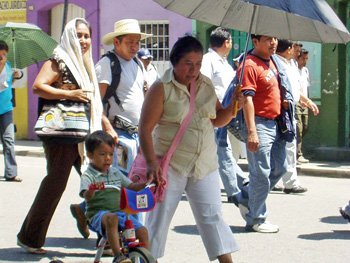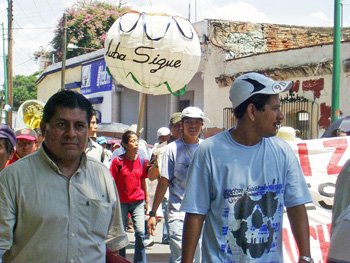


Two Years Later in Oaxaca: Part III
What’s the Difference - The Long Slow Process on the Ground and the Observance of June 14
By Nancy Davies
Commentary from Oaxaca
June 18, 2008
Read Part I and Part II of this series.
Part III
“We don’t forgive and we don’t forget” written on walls and signs and carried through the streets reminds us of the dead, tortured and disappeared of the 2006 uprising, commemorated on June 14 of 2008 with a march of teachers and the Asamblea Popular de los Pueblos de Oaxaca (APPO). The march took about seventy minutes to pass where I stood. So it was clearly a megamarch, maybe 60 -70,000 people, mostly teachers and their families.
 Photos DR. 2008 Nancy Davies |
When the march reached the zócalo, the Oaxaca union secretary Ezekial Rosales Careño was jeered by a handful of hooded youngsters, for the settlement which saw thezócalo emptied of tents and teachers by 7:30 PM. City workers came in with fire hoses and washed away the last remnants of this year’s encampment. The teachers disappeared, tents disappeared, vendors disappeared, the beggars remained.
By Sunday AM, the ambulatory vendors were back to solicit sales. Many buildings had already been repainted, but protest graffiti still exists. I would characterize the march as a simple non-combative declaration: here we are and the movement hasn’t vanished.
Contradictions
Certainly one big difference in Oaxaca since the 2006 eruption of the social movement lies in the overt contradictions, power struggles and confusion, the many unknowable back-room discussions, and the many secrets all but peeking around the door. On June 16 the daily paper Las Noticias Voz y Imagen de Oaxaca published an article headline “THERE WILL BE A CRIMINAL COMPLAINT AGAINST OFFICIALS FOR GENOCIDE AND FORCED DISAPPEARANCES” – a criminal complaint lodged with the national attorney general’s office against eight persons in power during 2006, starting with then-president Vicente Fox.
Nevertheless, disregarding the ants’ trek, we live in a stalemate with no exit in view before URO’s term of office expires.
URO maintains a dirty war, which includes paying provocateurs and gangsters in virtually every aspect of the state’s public life. URO politically has nothing to offer, his state is ungovernable, and he himself is an international liability as Calderon tries to peddle abroad a decent investment environment in Mexico. Oaxaca has one of the lowest foreign investment rates of any state.
 |
In a small side-disturbances on June 14, reports circulated that youngsters wearing masks, who apparently belonged to the Asamblea Popular de los Pueblos de Oaxaca (APPO), took by force four buses, a trailer belonging to the Bimbo bakery business, a gas tank truck, and a diesel truck, and held them at the crossroads of Cinco Señores, an important site for the barricades of 2006. The next morning the APPO spokesperson, César Mateos declared they were not APPO sympathizers; there were no accords to complain about at that hour of the morning. The next reports accused the hooded youngsters of being followers of Oaxacan Voices Constructing Autonomy and Freedom (VOCAL) and of David Venegas, the former political prisoner. These same hooded youths then appeared at the kiosk and heckled Section 22 secretary Ezekial Rosales Careño, throwing empty bottles and trash at him while he spoke.
The youngsters denouncing Rosales as a traitor blamed him for negotiating away an important aspect of the teachers’ assemblies: face-to-face discussion and voting. David Venegas told me that although VOCAL, an anarchist faction, opposed the announcement of the settlement prior to a consultation at the base, they were not involved in the physical trashing of Rosales.
Therefore, my guess is that the usual government provocateurs are at work, giving both the teachers and the APPO a bad rap. Insiders tell me that Section 22 is loaded with sell-outs and an internal power struggle is going on – that sounds normal. This is a social movement besieged both internally and externally.
Meanwhile, the People’s Revolutionary Army (EPR) was also putting pressure on Calderón to produce their two missing members. They announced that “time is running short” (La Jornada On Line 11/06/2008 14:44), without naming consequences. The EPR blames the federal government for dragging out the “negotiation” process which includes the investigation into who snatched Edmundo Reyes Amaya and Gabriel Alberto Cruz Sánchez – a job allegedly done in Oaxaca, master-minded by URO’s then secretary of government, Jorge Franco Vargas, and currently the head of the state PRI. Calderón went off to Spain the week of June 9 to talk about Spanish investment in Mexico.
While the EPR was demanding action, Mouriño declared that within the government of Calderón there are no cases of forced disappearance or political prisoners, completely ignoring the EPR’s (and human rights organizations’) list of 75 cases. The EPR’s other complaints include the usual: selling the country to foreigners, using the military and police to repress social movements while pretending to fight organized crime, and holding political prisoners. It puts the EPR very much into the same protest camp as the APPO, Section 22 teachers, and the Zapatistas. Although all sides deny connections, their causes match.
Section 22, having nudged Calderón to intercede on their behalf, decided not to break up their encampment less than a week before the June 14 megamarch commemoration of the 2006 attack. Instead, the union demanded that URO, whom they wouldn’t recognize during the past two years, meet with representatives of the APPO, to discuss the social issues behind the movement’s eruption.
 |
Add to this, that URO wanted to install (in fact did rip up and re-pave) another pedestrian tourist walkway, which would inevitably lead to corporate, not Mom-and-Pop, shops. Perhaps the shopkeepers see the neoliberal handwriting on the wall. They complained, and for the moment kept the streets open and the parking meters (another privatization of the streets) at bay. Letters to the editor complained: the business community wants URO out. Now URO is called on to meet with the APPO whomever that might be.
Section 22 released the public buildings, toll-booths on the highway and the access to the Pemex plant, on June 14. The teachers’ representatives achieved some positive things in their bargaining, such as the second year of salary raises for cost of living (re-zonification), grants to students for 22,500 pairs of shoes and 110,000 school uniforms, supplies, strengthening 612 community kitchens, and infrastructure. However, the question of schools still in the hands of the PRI Section 59, and the participation in the “secret balloting” next September, are not resolved, although Rosales Carreño, secretary of Section 22, assured the press that the agreement says that the only legally recognized union is 22, even if 59 attends their assembly!
He also said that the teachers are departing in order to return, stronger and with new strategies.
The Daily Struggle – A Way of Life
Many people believe that Section 22 acted wisely in not provoking more confrontations. The beloved Berta Muñoz, popularly known as la doctora Escopeta when she broadcast on Radio Universidad, has also returned, from exile in Bolivia. In an interview she said she does not see a return to barricades, encampments and mega-marches. But she does anticipate the continuing demand for the resignation of URO.
The difference now, she said in an interview printed online at Zapateando, between the popular rebellion headed by the APPO in 2006 and the appearance of new protests by teachers and organizations in the streets in 2008 is based, in her judgment “in that now, with all that has gone on, our consciousness is much more profound from the experience. Many people in the communities, the neighborhoods and the colonias are absorbed in the discrete work of constructing an organization which is more authentic, more solid, with the idea of democratizing Oaxaca which goes far beyond only throwing out Ulises Ruiz”.
She continued, “The other difference is the strategy of the new mobilizations: the teachers union acted, in my opinion, with a lot of wisdom in this moment: the encampments are small, they are staffed in rotation so as to not close all the schools at once, to cause the least harm possible to the school year and to not provoke social rejection. There is a clear distinction between what this movement is, and what the mobilizations are. One begins to understand that having not expelled the governor two years ago, because he was saved from falling by a (presidential) power negotiation, does not necessarily imply a defeat”.
During the last offensive blow by the Federal Preventive Police against the APPO, together with massive and indiscriminate arrests, Dr. Muñoz received death threats and orders of arrest were issued against her. She opted for exile in Bolivia. Some weeks ago she decided to return to Mexico, and she is “gathering her courage” to make the next step – return to Oaxaca, when the lawyers, among them Centro de Derechos Humanos Miguel Agustín Pro Juárez, resolve the arrest orders still outstanding. “When it’s resolved, I will come back. I long to return to my home and my life.”
The federal deputy and president of the commission for Citizen Participation of the Congress of the Union, Alberto Esteva Salinas, was quoted in Las Noticias on Monday, June 16, 2008 as saying that the state of Oaxaca is “putrid with impunity “. The three levels of government, he says, work together to sack the state, in every sense of the word. They feel no obligation to society. Esteva Salinas declared that after two years of intense conflict the economy is badly damaged. He claims it will take more than a decade to recuperate socio-economic stability; there is no authority in Oaxaca that works to benefit the people, but rather to “benefit a rapacious clique”.
He compared the Oaxaca capital with cities in other states such as Jalapa, Veracruz, Chilpancingo, Guerrero, and Morelia, saying that Oaxaca is thirty years behind them in economic development. The governor Ulises Ruiz Ortiz is to blame for the instability: “We live in a permanent encampment, the teachers are not paid attention to, nor the business people, and whoever wants a different Oaxaca is ignored.”
As one resident commentator, I note the alternative choice of the pueblos, especially the indigenous, who don’t necessarily want Esteva’s kind of “development”, but wish to maintain decent lives for themselves and their children with community and autonomy, without the power structure that accompanies external financial enterprises.
The dirty war instituted by URO imposes a third framework for Oaxaca. And a fourth is the media war: outing the PRI, PAN and military-police corruption. The Noticias article of June 16 totals the 2006 crimes: 26 assassinated, 366 detained who were tortured, 200 wounded. And it names the accused: Vicente Fox Quesada, Eduardo Medina Mora, Ulises Ruiz Ortiz, Rosa Lizbeth Caña Cardeza, Lino Celaya Luria, Manuel Moreno Rivas, José Manuel Vera Salinas.
We’ll see how far the accusations get in court, but also in the corporate boardrooms which hire ex-politicians and presidents. At the very least, the crimes have become common knowledge. And, “we don’t forgive and we don’t forget”.
Related information: For Narco News – Oaxaca Archives or Order a Copy of Nancy Davies’ The People Decide: Oaxaca’s Popular Assembly
Click here for more Narco News coverage of Mexico
- The Fund for Authentic Journalism
For more Narco News, click here.




